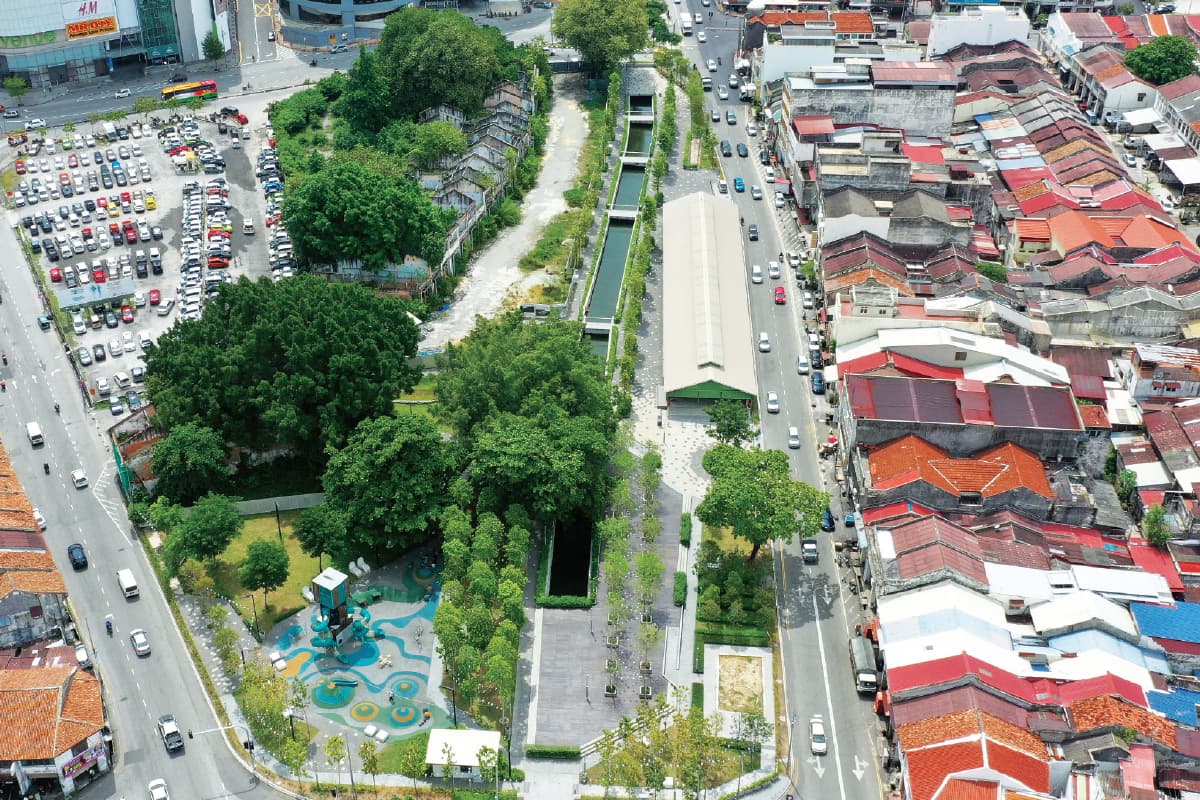
This article first appeared in The Edge Malaysia Weekly on December 21, 2020 - December 27, 2020
Honorary Mention | Sia Boey Urban Archaeological Park Phase 1 | PERBADANAN PEMBANGUNAN PULAU PINANG
The 2.53-acre Sia Boey Urban Archaeological Park in George Town, Penang, is a small green lung in the middle of the bustling city centre. It is part of the 5.45-acre Phase 5 of the Komtar Masterplan Development by Perbadanan Pembangunan Pulau Pinang or Penang Development Corporation (PDC). Surrounded by trees, shrubs and bushes, the beautiful community park has significant historical value because of its location, canal and market hall.
In the early days of George Town, the area was known as “Sia Boey” to the Hokkiens and “Ujong Pasir” to the Malays — both of which means “end of the village” — owing to its location, which was at the southernmost end of the settlement.
It was once a busy trading hub centred around the Prangin Canal, which was first used as a defensive ditch in the early 1800s during the Napoleonic Wars and considered to be the boundary of George Town.
The canal was an important route of transport for goods, which were brought inland from the coastline using tongkang or perahu (a type of boat).
In 1882, the canal was modified and subsequently, a market hall was built. According to BYG Architecture Sdn Bhd director Michael Ong, the Prangin Canal and Sia Boey Market Hall were best known to locals as a meeting place where the community converged to trade, shop, eat, seek entertainment and commute.
Today, the Sia Boey Urban Archaeological Park is located within the site, which is bounded by Lebuh Carnarvon, Jalan Magazine, Jalan C Y Choy and Jalan Dr Lim Chwee Leong.
The site is being developed in three phases. Phase 1 was given an honorary mention at The Edge Malaysia-PAM Green Excellence Award this year.
Rehabilitation and rejuvenation of the canal
Phase 1 was divided into two sub-phases. Phase 1A, which involved the diversion of the 200m Prangin Canal to a new concealed drain with higher capacity, commenced in 2015 and took 13 months to complete.
According to BYG’s Ong, the canal had functioned as the main drain prior to the commencement of work in Phase 1A. The water in the canal mainly came from rainwater runoff as well as the buildings within the 278-acre catchment area, which encompassed a large portion of the George Town Unesco World Heritage Site.
During dry spells, the water level would be lower and there was often sludge build-up at the invert that reeked.
“Hence, the diversion was essential to activate the other phases of the construction works at the site, having evaluated the historical significance whilst taking into consideration the importance of the canal’s functionality,” Ong explains.
After the completion of Phase 1A, the rehabilitation of the canal and installation of filters started in 2018 under Phase 1B and it was completed in six months.
The canal was thoroughly cleaned and de-sludged, with portions of the granite block wall repaired and reapplied with lime mortar. Other works included the insertion of a reversible liner and a circulation system to create a water-tight tank ecosystem, and the installation of a bio-filtration system downstream. The waterbody was also treated with effective microorganism, a proven Japanese bio-remediation technology.
After the works were completed, a large school of koi and other aquatic life were introduced to the stream. Apart from adding life to the park, the fishes also help control the spread of mosquitoes.
In 2019, Phase 2, which lasted eight months, commenced and encompassed the conservation of the market hall and construction of the park where the existing trees as well as those on the archaeological site were kept.
Overcoming challenges and looking to the future
The entire 5.45-acre site was originally slated for residential and commercial developments by PDC. “Even though the original intent was to generate revenue for PDC due to the area’s prime location, we decided to forgo the plan for a low-key, green-concept and community-centric development that will eventually provide a green lung for the city,” says Datuk Mohd Bazid Abdul Kahar, general manager of the development agency of the Penang government.
When PDC made archaeological findings within the site in 2015, it was inspired to rethink Sia Boey as an urban archaeological park that would be in line with the Penang 2030 vision of a family-focused green and smart state, he adds.
The findings included a granite structure, which has been identified as an old canal lock and canal basin; cultural artefacts; and old construction materials.
As the site holds great sentimental value for the local community, all activities on-site had invited speculations and negative comments, says Ong.
“However, with the heritage expertise of George Town World Heritage Incorporated and the consultants engaged in the project, we were able to incorporate archaeological, cultural and heritage elements into the park. This has led to the successful creation of a park which caters for all walks of life and that everyone likes to visit,” he explains.
For the remaining land within the site, the plan is to harness the opportunities created by the upcoming Komtar light rail transit (LRT) station, says PDC’s Mohd Bazid.
Sited in the remaining land are two rows of heritage shophouses, the first of which only has two units. To be restored under the tentatively named Phase 2A, the two units will be joined by park facilities such as public toilets, small retail lots and a management office.
The other row of shophouses, known as Phase 3, has 22 units and will be integrated with the future LRT station. There will also be an extended overhead link to Komtar that has been designed with the immediate shophouses and the World Heritage Site in mind.
Save by subscribing to us for your print and/or digital copy.
P/S: The Edge is also available on Apple's AppStore and Androids' Google Play.